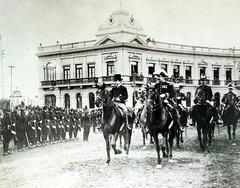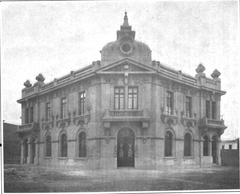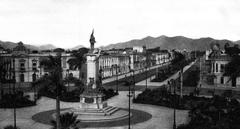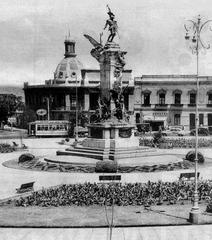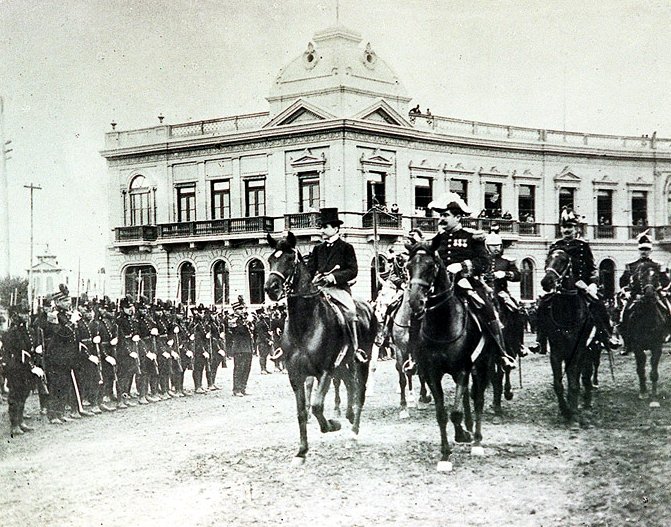
Bolognesi Square Lima: Visiting Hours, Tickets & Historical Sites Guide
Date: 14/06/2025
Introduction: Bolognesi Square’s Significance in Lima, Peru
Bolognesi Square (Plaza Bolognesi) stands as one of Lima’s most emblematic urban landmarks, embodying Peru’s republican heritage and the city’s transformation from a colonial stronghold into a vibrant modern metropolis. Strategically located at the intersection of several major avenues—Avenida Brasil, Avenida Arica, and Avenida Alfonso Ugarte—it marks a symbolic gateway bridging the historic center and Lima’s modern districts. The square’s design, urban setting, and historic monument collectively narrate the evolution of Peruvian identity and city life (elcomercio.pe; Wikiwand).
Table of Contents
- Introduction
- Historical Overview: From Fortified City to Urban Landmark
- The Monument to Francisco Bolognesi: Art and Symbolism
- Urban Development and Modernization
- Social, Political, and Cultural Life
- Restoration and Urban Challenges
- Geographic Location & Urban Setting
- Transportation & Accessibility
- Neighborhood Character & Safety
- Visitor Information (Hours, Tickets, Events)
- Visitor Experience & Practical Tips
- Cultural Integration & Broader Significance
- Conservation Efforts
- Frequently Asked Questions (FAQ)
- Recommended Resources & References
Historical Overview: From Fortified City to Urban Landmark
After Lima’s colonial walls were demolished between 1868 and 1870, a new urban vision emerged. Bolognesi Square was conceived as a statement of republican progress, opening in 1905 with a French-inspired circular esplanade. The square’s central monument was the result of a grassroots campaign initiated by students to honor Colonel Francisco Bolognesi, a Peruvian hero of the War of the Pacific (elcomercio.pe).
The Monument to Francisco Bolognesi: Art and Symbolism
At the heart of the plaza stands the Monument to Colonel Francisco Bolognesi, designed by Spanish sculptor Agustín Querol. The bronze statue depicts Bolognesi in full military regalia, holding the Peruvian flag aloft—a symbol of his legendary vow to fight “to the last cartridge” during the Battle of Arica (infobae.com). The monument, with its expressive detail and granite pedestal adorned with high-relief panels, became a focal point for national commemorations, especially on June 7th, Flag Day.
The monument has witnessed changes reflecting broader cultural shifts, including a controversial replacement of the original statue in the late 20th century, which sparked public debate and calls for restoration (infobae.com).
Urban Development and Modernization
Bolognesi Square’s creation coincided with Lima’s modernization: the expansion of railways, trams, and roads pushed the city’s growth beyond its colonial core (worldofhistorycheatsheet.com). The square’s Beaux-Arts-inspired design, with avenues radiating from a central monument, established it as both a ceremonial space and a bustling urban roundabout. Its landscaped gardens and distinctive republican-era architecture reflect Lima’s early 20th-century aspirations (elcomercio.pe).
Social, Political, and Cultural Life
Throughout the 20th century, Bolognesi Square became a stage for civic events, military parades, and spontaneous demonstrations, symbolizing national pride and resilience (worldofhistorycheatsheet.com). It remains an important venue for annual ceremonies, especially the Día de la Bandera, which gathers citizens, officials, and veterans for patriotic tributes (infobae.com).
Restoration and Urban Challenges
Recognized as part of Lima’s historic center—a UNESCO World Heritage Site—Bolognesi Square has undergone ongoing restoration. Projects spearheaded by the municipal agency Prolima aim to recapture its 1950s grandeur, with granite paving, new benches, and enhanced landscaping, while balancing the challenges of heavy traffic and urban pressures (elcomercio.pe).
Geographic Location & Urban Setting
Exact Location
Bolognesi Square lies at the confluence of Brazil, Arica, Alfonso Ugarte, Guzmán Blanco, and 9 December Avenues (Wikiwand; Wikipedia). The square straddles the boundary between the Lima and Breña districts. Its coordinates are approximately -12.0582 latitude and -77.0431 longitude (Mapcarta).
Urban Context & Architectural Surroundings
Inaugurated in 1905, the square was designed as a monumental roundabout with radial urban blocks, originally flanked by blue-painted republican-style buildings (Wikiwand). Though many buildings have suffered deterioration, the layout remains a testament to Lima’s early 20th-century urbanism.
Proximity to Key Landmarks
- Lima Art Museum (Museo de Arte de Lima): ~1.5 km southeast (Mapcarta)
- Italian Art Museum: Nearby, with European art collections
- Santa Beatriz Neighborhood: Historic and commercial
- Central Lima & Plaza Mayor: UNESCO-listed historic core (peru.info)
Transportation & Accessibility
Public Transportation
Bolognesi Square is well-connected:
- Multiple bus lines serve the square and adjacent districts (Wanderlog)
- Metropolitano BRT stations (Estación Central, Estación España) are within walking distance
- Taxis and rideshare services (Uber, Beat, Cabify) are widely available (Lonely Planet)
Road Access & Traffic
As a major roundabout, the square experiences heavy traffic during rush hour (7–9 AM, 5–8 PM). Plan visits outside peak times for convenience (Lonely Planet).
Pedestrian Access & Accessibility
Pedestrian access is possible via crosswalks, though visitors must be cautious due to traffic. Sidewalks are present but may be uneven; ramps and tactile paving are limited. The square itself is accessible, but those with mobility concerns may prefer taxis for direct drop-off.
Proximity to Airports
- Jorge Chávez International Airport: ~11 km northwest, 30–45 minutes by car (Lonely Planet)
Neighborhood Character & Safety
The area is mixed-use, combining residential, commercial, and institutional spaces. The square is vibrant during the day, especially during events, but visitors should take standard safety precautions, particularly at night (Lonely Planet).
Visitor Information: Hours, Tickets, Events
- Visiting Hours: Open 24 hours; daylight hours (8 AM–6 PM) recommended
- Tickets: No entrance fee; public space
- Special Events: Flag Day (June 7) features military parades and ceremonies (Wikipedia)
- Guided Tours: Many city tours include the square as a stop
Visitor Experience & Practical Tips
Monument & Architectural Features
The bronze statue of Bolognesi, set atop a granite pedestal with narrative reliefs, is the centerpiece. The plaza’s radial layout and landscaped gardens offer ample space for viewing and photography (Backpackers Blueprint).
Atmosphere & Local Life
On typical days, the square is lively with commuters, street vendors, and occasional tourists. National holidays transform it into a solemn ceremonial space, especially on June 7th.
Practical Tips
- Location: Intersection of Avenida Brasil, Alfonso Ugarte, and Arica
- Best Visiting Times: Early morning or late afternoon for optimal lighting and fewer crowds
- Nearby Attractions: Plaza Mayor, Cathedral of Lima, Museo de la Nación (MissTourist)
- Dining: Numerous local restaurants and cafes nearby
- Facilities: Limited on-site; nearby shops and cafes offer refreshments
Cultural Integration & Broader Significance
Bolognesi Square, together with Plaza Mayor and Plaza San Martín, forms part of Lima’s network of plazas that commemorate key historical moments and figures (The Collector). It provides insight into Peru’s struggle for sovereignty and national identity, especially through its annual ceremonies and educational value (LimaEasy).
Conservation Efforts
The Municipality of Lima conducts regular restoration and maintenance of Bolognesi Square, preserving its historical character amid urban pressures such as traffic and pollution (Peru For Less). Current efforts focus on enhancing pedestrian experience and reviving the square’s mid-20th-century appearance.
Frequently Asked Questions (FAQ)
Q: Is Bolognesi Square open to the public at all times?
A: Yes, it is accessible 24/7, but visiting during daylight is safest.
Q: Is there an entrance fee?
A: No, the square is free to visit.
Q: Are guided tours available?
A: Yes, many local and online tour operators include the square in their Lima historic center routes.
Q: Is the square accessible for people with disabilities?
A: The plaza has ramps and paths, but sidewalks may be uneven; nearby museums offer better accessibility.
Q: When is the best time to visit for special events?
A: June 7th, Flag Day, features significant patriotic ceremonies.
Recommendations for Visitors
- Combine your visit with Plaza Mayor and Plaza San Martín for a full historical experience (MissTourist).
- For a unique cultural experience, attend the Flag Day ceremonies on June 7th.
- Explore local eateries for Peruvian cuisine.
- Use guided city tours or apps like Audiala for deeper insight and easier navigation.
Visual Resources
For maps, virtual tours, and images, consult Lima tourism websites and the Audiala app. These resources provide visual context and planning tools for your visit.
Summary and Final Tips
Bolognesi Square is a living monument to Peru’s national identity and urban history. Its iconic monument, ceremonial role, and architectural layout offer visitors a rich cultural experience. With free, all-day access and proximity to major attractions, the square is an essential stop for anyone exploring Lima’s historic heart. Restoration efforts and improved accessibility continue to enhance the visitor experience (infobae.com; Wikipedia; Lonely Planet; elcomercio.pe; LimaEasy).
For up-to-date information, event notifications, and guided tours, download the Audiala app and follow local tourism channels.
References
- elcomercio.pe
- infobae.com
- worldofhistorycheatsheet.com
- Wikiwand
- Wikipedia
- Mapcarta
- Lonely Planet
- Backpackers Blueprint
- LimaEasy
- MissTourist
- The Collector
- Peru For Less
- Wanderlog
- Free Walking Tours Peru
